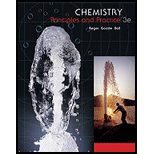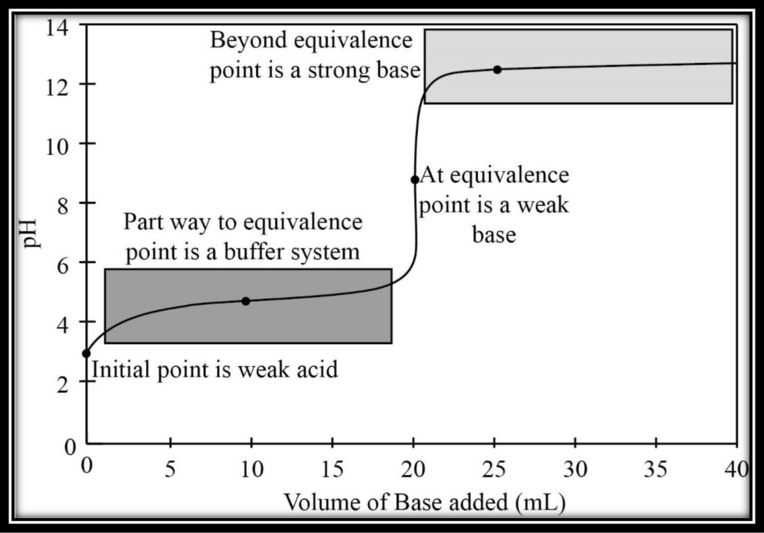
Concept explainers
Interpretation:
The titration of acetic acid (CH3COOH) with sodium hydroxide (NaOH), both 0.100 M. The titration curve has to be drawn and four regions of importance have to be labeled.
Explanation of Solution
Addition of
Acetic acid is a weak acid. The initial point in the titration when the base is not added to the system, the system is a weak acid system.
The iCe table can be set up to calculate the
Where,
The
This can be solved by approximation. If
The
Addition of
The neutralization reaction can be written as given,
Calculation of milimole of acid and base:
Making of sRfc table:
The table can be formed as shown below.
The molar ratio of acid and base is
All the strong base is consumed. There are weak acid
Addition of
Calculation of milimole of acid and base:
Making of sRfc table:
The table can be formed as shown below.
The molar ratio of acid and base is
Both
The iCe table can be set up to calculate the
The expression for
The value of
This can be solved by approximation. If
The
Addition of
Calculation of milimole of acid and base and total volume:
Making of sRfc table:
The table can be formed as shown below.
The molar ratio of acid and base is
Now, the
Titration curve:
The titration curve is plotted between volume of base added and the corresponding
The titration curve with four important regions is given below.

Figure 1
Want to see more full solutions like this?
Chapter 16 Solutions
Chemistry
- Sketch a titration curve for the titration of potassium hydroxide with HCl, both 0.100 M. Identify three regions in which a particular chemical species or system dominates the acid-base equilibria.arrow_forwardCalculate the mass of sodium acetate, NaCH3COO, you should add to 500. mL of a 0.150-M solution of acetic acid, CH3COOH, to buffer a solution at a pH of 4.57.arrow_forwardKa for formic acid is 1.7 104 at 25C. A buffer is made by mixing 529 mL of 0.465 M formic acid, HCHO2, and 494 mL of 0.524 M sodium formate, NaCHO2. Calculate the pH of this solution at 25C after 110 mL of 0.152 M HCl has been added to this buffer.arrow_forward
- The pH of 0.10 M CH3NH2 (methylamine) is 11.8. When the chloride salt of methylamine, CH3NH3Cl, is added to this solution, does the pH increase or decrease? Explain, using Le Chteliers principle and the common-ion effect.arrow_forwardWhich of the acid-base indicators discussed in this chapter would be suitable for the titration of (a) HNO3 with KOH. (b) KOH with acetic acid. (c) HCl with NH3. (d) KOH with HNO2. Explain your answers.arrow_forwardIn the laboratory, a general chemistry student measured the pH of a 0.580 M aqueous solution of aniline, C6H5 NH2 to be 9.332. Use the information she obtained to determine the K for this base. K(experiment)arrow_forward
- Pyridine, C5H5N, is a weak base with Kb = 1.5 × 10-9. What is the pH at the equivalence point when 0.50 M pyridine is titrated with 0.50 M HClarrow_forwardAdding as little as 0.1 mL of concentrated HCl to a liter of H2O shifts the pH from 7.0 to 3.0. Adding the same amount of HCl to a liter of a solution that 0.1 M in acetic acid and 0.1 M in sodium acetate, however, results in a negligible change in pH. Why do these two solutions respond so differently to the addition of HCl?arrow_forwardSelect the mixture that is capable of tolerating the addition of a strong acid without altering the pH Group of answer choices 1.0 M NH3 and 1.0 M NaCl 1.0 M HCl and 1.0 M NaCl 1.0 M HNO2 and 1.0 M NaNO2 1.0 M HF and 1.0 M NaClarrow_forward
- a .1000 M solution of a weak acid, HA, is 3.0% dissociated. Determine the value of Ka for the weak acidarrow_forwardCalculate the pH during the titration of 30 mL of 0.1000 M NaOH(aq) with 0.1000 M HCI(aq) after 12.35 mL of the acid have been added.arrow_forwardA sample of acetic acid is titrated with a standardized NaOH solution. Before the end-point of the titration, which of the following must be true? HC2H3O2(aq)+NaOH(aq)⟶NaC2H3O2(aq)+H2O(l) Note: [X] = molar concenctration of X choices [H+] < [OH-] [H+] = [OH-] [H+] > [OH-]arrow_forward
 Chemistry: Principles and PracticeChemistryISBN:9780534420123Author:Daniel L. Reger, Scott R. Goode, David W. Ball, Edward MercerPublisher:Cengage Learning
Chemistry: Principles and PracticeChemistryISBN:9780534420123Author:Daniel L. Reger, Scott R. Goode, David W. Ball, Edward MercerPublisher:Cengage Learning Chemistry: The Molecular ScienceChemistryISBN:9781285199047Author:John W. Moore, Conrad L. StanitskiPublisher:Cengage LearningChemistry: Matter and ChangeChemistryISBN:9780078746376Author:Dinah Zike, Laurel Dingrando, Nicholas Hainen, Cheryl WistromPublisher:Glencoe/McGraw-Hill School Pub Co
Chemistry: The Molecular ScienceChemistryISBN:9781285199047Author:John W. Moore, Conrad L. StanitskiPublisher:Cengage LearningChemistry: Matter and ChangeChemistryISBN:9780078746376Author:Dinah Zike, Laurel Dingrando, Nicholas Hainen, Cheryl WistromPublisher:Glencoe/McGraw-Hill School Pub Co General, Organic, and Biological ChemistryChemistryISBN:9781285853918Author:H. Stephen StokerPublisher:Cengage Learning
General, Organic, and Biological ChemistryChemistryISBN:9781285853918Author:H. Stephen StokerPublisher:Cengage Learning General Chemistry - Standalone book (MindTap Cour...ChemistryISBN:9781305580343Author:Steven D. Gammon, Ebbing, Darrell Ebbing, Steven D., Darrell; Gammon, Darrell Ebbing; Steven D. Gammon, Darrell D.; Gammon, Ebbing; Steven D. Gammon; DarrellPublisher:Cengage Learning
General Chemistry - Standalone book (MindTap Cour...ChemistryISBN:9781305580343Author:Steven D. Gammon, Ebbing, Darrell Ebbing, Steven D., Darrell; Gammon, Darrell Ebbing; Steven D. Gammon, Darrell D.; Gammon, Ebbing; Steven D. Gammon; DarrellPublisher:Cengage Learning




